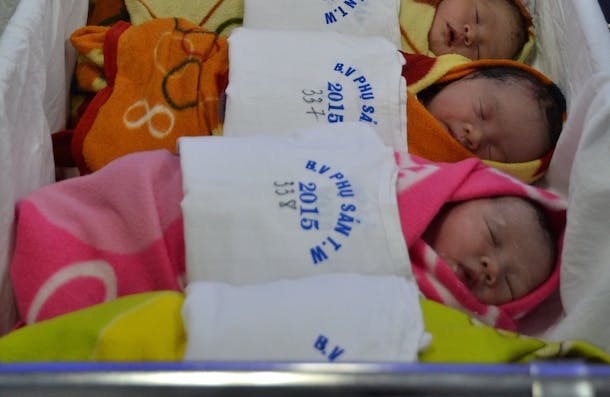
On a sunny, mild day in January, I had the opportunity to accompany a group of international journalists on a visit to Viet Nam’s National Hospital for Obstetrics and Gynecology. This 700-bed facility in the heart of Hanoi is staffed by nearly 500 nurses and approximately 150 doctors.
Each year, this team of health professionals oversees tens of thousands of deliveries, surgeries, and other complex medical procedures, earning it the reputation of being the top hospital for mothers and babies in the country. The largest problem for the hospital’s professional staff comes from issues of overcrowding – something we witnessed firsthand during a visit to the newborn intensive care unit where the bassinets sometimes held three or four babies each.
Despite being crowded, the facility was clean and stocked with modern technology and medicine. The staff was highly trained and professional. The survival rate for newborns and mothers was high.
A few days later, our group experienced something completely different only 500 kilometers (310 miles) from Hanoi. Dien Bien province in the mountainous northern part of the country is considered one of the poorest parts of Viet Nam. It is home to a number of distinct ethnic minority groups, many of whom live in remote villages that lie deep in the mountains and are only reachable over bumpy dirt roads. During the rainy season, these roads are often impassable.
For women in rural communes, such as the Hua Ngai commune our group visited, the closest hospital may be 40 kilometers or more away. In the case of an emergency, a woman’s family might have to carry her that distance in a hammock, if an ambulance isn’t available or can’t navigate the roads. For most women, the act of bringing a new life into the world happens in the dirt floor huts that they call home. The sterile rooms of the National Hospital for Obstetrics might as well be a world away.
Since the adoption of the Millennium Development Goals (MDGs), eight goals established by world leaders and the United Nations in 2000 to reduce poverty, Viet Nam has made some of the most impressive progress of any country in the world in terms of reducing maternal and child mortality. But this progress has been uneven across the country, and the maternal death rate in Dien Bien is three times higher than the national average.
UN agencies, such as the World Health Organization and UNICEF, have worked closely with the Vietnamese government to address geographic and ethnic disparities. They have made innovative strides toward providing health care in the hardest-to-reach places, such as Hua Ngai commune.
One example is the ethnic minority midwives program, which offers six months of training to local villagers so they can deliver invaluable health advice and services to pregnant women in their communities. The women in these programs – some as young as 16-years-old – have helped bring down maternal mortality rates in Hua Ngai and other communes throughout Dien Bien.
UN Secretary-General Ban Ki-moon has said that, “In adopting the Millennium Development Goals (MDGs), world leaders committed to create a more equal and just world.” Viet Nam offers an important reminder that inequalities persist not just between wealthy and low-income nations, but also within countries themselves. As the world agrees upon goals for the post-2015 era, it will be important to ensure that progress on a national level doesn’t mask the challenges that remain in a country like Viet Nam.



 View All Blog Posts
View All Blog Posts